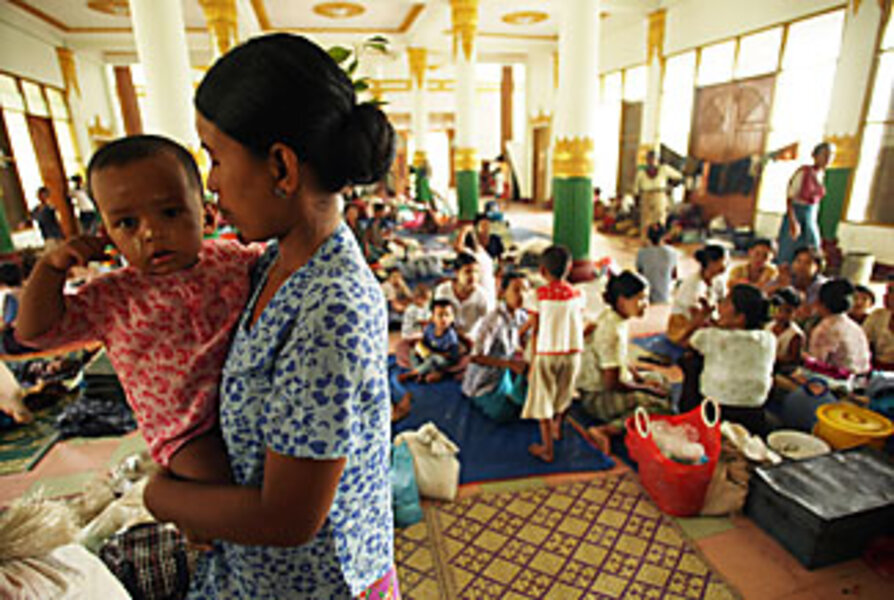Burmese forced from relief camps
| Bangkok, Thailand
Aid agencies trying to help cyclone survivors in Burma (Myanmar) are increasingly bumping up against what appears to be a coordinated government drive to close temporary relief camps in towns and send villagers back home, sometimes by force, to fend for themselves.
Human rights groups say that forced evictions from relief camps – which include churches, monasteries, schools, and other public buildings – are putting lives at risk and flouting international principles of humanitarian relief. A new report by Amnesty International lists 30 cases since May 19 of forcible removals of thousands of people who sought temporary shelter after last month's cyclone.
"They're being returned to villages and townships that have been devastated, and their right to food, shelter, and medical help is being violated," says Benjamin Zawacki, the author of the report.
Behind the closures is a secretive military junta that fears the presence of foreign aid groups and wants to disperse communities that could foment opposition to its iron-fisted rule, say analysts and Burmese dissidents.
Sending people home also provides a labor force that can be corralled into working for little or no pay. Last week, the International Labor Organization warned that Burma may use forced labor in cyclone reconstruction, as it has on other infrastructure projects in the past.
Closures complicate aid work
Ever since cyclone Nargis pummeled southern Burma a month ago, leaving devastation in its wake, aid agencies have been struggling to reach stricken communities and figure out how and where to send assistance.
At least 134,000 people are listed as dead or missing, though exiled Burmese opposition groups say the death toll is likely to be much higher.
As in other natural disasters, ad hoc relief camps have become vital distribution points for food and medical services. About 260,000 people have sought temporary shelter, out of more than half a million people who have left their homes, according to United Nations estimates. Some are in government-run tent cities that have been shown off to visiting donors.
Aid workers say the closure of town shelters is likely to compound the challenge of providing aid, on top of the already stifling controls imposed on foreign aid groups. These controls have loosened slightly since UN Secretary General Ban Ki Moon visited Burma two weeks ago, but relief agencies are still dogged by bureaucratic obstacles.
The US military is withdrawing four warships that have circled off the Burmese coast for weeks, waiting to deliver cyclone aid.
Humanitarian workers have warned of a second wave of deaths from malnutrition and disease in remote, waterlogged corners of the Irrawaddy Delta that have received little or no assistance.
UN officials who have collected reports of camp evictions say they have expressed their concern to Burmese government officials and been told that there is no official eviction policy. "We are concerned at any return [of people] to areas that don't have the right services and where people's lives and livelihoods can't be sustained," Amanda Pitt, a spokesperson for the UN's humanitarian arm, told a news conference in Bangkok.
Junta eager to rebuild 'rice bowl'
In recent weeks, however, Burmese leaders have repeatedly called for a rapid start to reconstruction in the delta, a major rice-growing area. They've also requested $11 billion in foreign aid. Asia Times Online, a news website, has reported that 43 Burmese companies have already received contracts for reconstruction in cyclone-hit areas, including some owned by businessmen under US and other Western financial sanctions.
Burmese state media has also scolded villagers who wait by the roadside for private handouts and struck a defiant tone toward international food aid, saying villagers can forage for fish and frogs in monsoon ponds. This fits the junta's vision of self-sufficiency and intense suspicion of Western-led relief efforts, say analysts.
"When they see white faces, they see spies.... They don't want anyone looking around there," says Aung Naing Oo, an exiled Burmese scholar based in Chiang Mai, Thailand.
In private, UN officials say they are appalled by the recent camp closures but wary of openly criticizing Burma's authorities and seeing the door slam on their aid programs. This caution is understandable, say human rights activists and Burmese exiles, but provides little comfort to the cyclone victims whom the international community has pledged to protect.
UN agencies "are scared to speak out and expose the real situation, because they don't want to jeopardize a fragile relationship with the military junta.... It's really frustrating for Burmese staff who work for UN and international NGOs," says Aung Zaw, editor of the Irrawaddy magazine in Thailand, which has reported on camp evictions.
Anxious to go home, but with help
Despite the hardships, cyclone survivors are often anxious to go home and start again, provided they have enough support, say aid workers. A return to daily routines can help ease the trauma and dislocation caused by the cyclone.
On Monday, hundreds of schools reopened for the first time since the cyclone, though not in all storm-hit areas. More than 4,000 were damaged by the cyclone, of which over 1,000 were utterly destroyed, according to United Nations Children's Fund (Unicef).
The UN Development Program has begun a livelihoods program in 250 villages that includes cash grants and small infrastructure projects. This should help villagers get back on their feet, though not at the expense of the relief efforts that are still taking shape, says Sanaka Samarasinha, deputy UNDP chief in Rangoon.
"There are communities that are in a recovery phase, and we should address their needs while not taking our eyes off the ball on relief work," he says.





